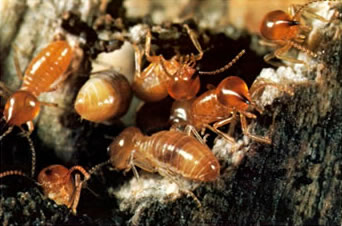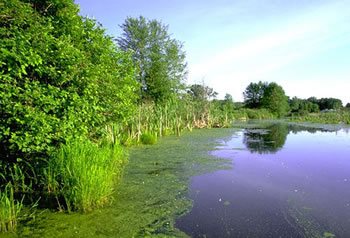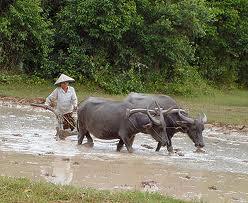Methane - The Most Dangerous Gas in Our Everyday Lives!
Of Termites, Cows and other things!
 Just from a purely environmental point of view we need to examine the impact of life in general in this country and what negative environmental effect it is having, and then just what can be done to lessen deadly emissions of Methane gas (CH4).
Just from a purely environmental point of view we need to examine the impact of life in general in this country and what negative environmental effect it is having, and then just what can be done to lessen deadly emissions of Methane gas (CH4).
Next time you read or hear of some bureaucrat carping on about Carbon Monoxide contamination they generally need informing of the true problem of Methane gases that are some 20 times more dangerous or toxic.
So what of termites and cows? They are the two greatest natural producers of Methane gas, and of those the most prolific is the termite! You could argue that the terrible termite is not too much of a problem here in the United Kingdom, but you could be wrong, as once more they have appeared in rural Devon, not a million miles away from here. Whilst our current climate is not likely to encourage them much, they are highly adaptable and very industrious little beasts.
 Admittedly in other parts of the world they are a huge destructive force, relatively few people are aware that they are the largest natural producers of the deadly methane gas on the planet. They also have a positive role to play in the greater scheme of life, as indeed do the next couple of enormous players in the methane production arena. Whilst termites may at the moment be minimal in our country, natural wetlands, so rightly protected by Peter Scott and others, are the next culprits. Cattle too give forth far more methane than is good for the planet and there are plenty of those in our countryside.
Admittedly in other parts of the world they are a huge destructive force, relatively few people are aware that they are the largest natural producers of the deadly methane gas on the planet. They also have a positive role to play in the greater scheme of life, as indeed do the next couple of enormous players in the methane production arena. Whilst termites may at the moment be minimal in our country, natural wetlands, so rightly protected by Peter Scott and others, are the next culprits. Cattle too give forth far more methane than is good for the planet and there are plenty of those in our countryside.
Moving abroad again, paddy fields and rice production rank at number three on the ladder.
 Humans need the lowly termite, the productive cow, the wetlands and the paddy fields for their very existence in many cases. So our lives go hand in hand with a potential naturally produced killer - Methane.
Humans need the lowly termite, the productive cow, the wetlands and the paddy fields for their very existence in many cases. So our lives go hand in hand with a potential naturally produced killer - Methane.
We human custodians of the planet and its well being are responsible for massive production of methane through unnatural causes and the one that directly affects us most is landfill. Landfill's rotting deposits contain the bacteria that multiply just as effectively as those found in the lowly termite or the wonderful wetlands, and so we have created the very ideal conditions in which the gas can be created in huge volumes. If you look carefully at any landfill site you are, today, likely to see small chimney like pipes protruding up through the surface of the landfill. These are vents let into the landfill allowing the methane to escape into the atmosphere.
 Almost everything we do, from driving our vehicles to keeping a garden compost unit produces "unnatural" methane gas, and we simply have to change that before it changes us - permanently.
Almost everything we do, from driving our vehicles to keeping a garden compost unit produces "unnatural" methane gas, and we simply have to change that before it changes us - permanently.
So what is the solution? On the one hand there is natural production and there are beginning to appear ways and means of capturing the naturally produced methane and in various ingenious ways turning it into a useful, free commodity - fuel.
The unnatural landfill production of methane is caused by the rapid multiplication of bacteria anaerobically, that is to say without oxygen. Today you will find that water treatment works, previously recognised as sewerage works, for example, are turning the same anaerobic principle to our advantage. Large farms, mainly in Canada, the United States, and Australia, with one or two here in the UK are also adopting methane capturing methods. Water treatment works and farms are using their free commodity of human and animal waste to multiply methane production speeds and turn the dangerous gas into fuel for energy and thereby reducing the amounts released into the atmosphere considerably.
Methane gas capturing and then its utilisation have huge economic and physical advantages over and above alternative methods of energy production. The equipment is straight forward, relative inexpensive, easy to install and maintain, and very safe. It is aesthetically pleasing, non intrusive, and almost silent. It does not rely on unreliable factors such as wind or water power, and most importantly does one thing that alternative energy schemes do not. It takes corruptive and dangerous toxic gas out of the atmosphere.
Just how is it all done? It is in effect very simple. We have had a quick look at the main causes of Methane gas production, both natural and unnatural, and shortly we will take an in depth look at how we are beginning to take control of what is at first a toxic waste and how that is turned into energy.
Competition
In connection with the environmental article on methane production Wincanton Window is giving it's readers a chance to contribute their own ideas for capturing gas from cows! Design your own "cow" gas capturing system and you could go into the history books as some one who saved the planet, but more likely be one of the entries published in Wincanton Window.
It is open to two groups of people those up to and including 15 years of age, and those over.
Simply submit your design attached to an email to together with your date of birth if under 15, and your contact email address.
Clive Rogers
Comments
Login to comment!